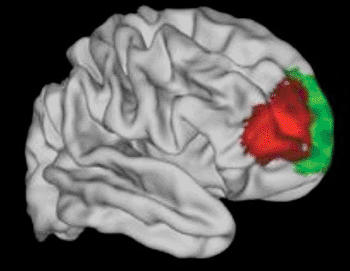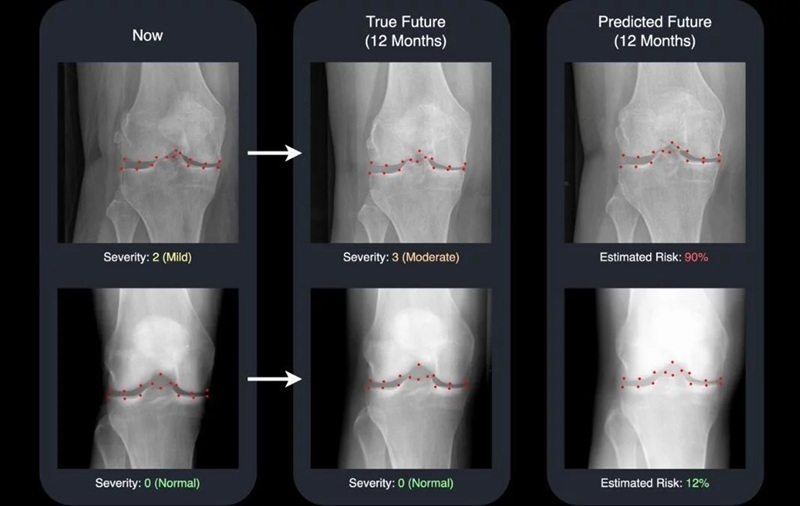Imaging Shows Unique Brain Region Tied to Higher Cognitive Abilities
|
By MedImaging International staff writers Posted on 18 Feb 2014 |

Image: An area (red) of the brain that seems to be unique to humans (Photo courtesy of the University of Oxford).
British researchers have pinpointed an area of the human brain that appears unlike anything in the brains of some of human’s closest relatives. The brain area identified is known to be closely involved in some of the most advanced planning and decision-making processes that people think of as being expressly human.
“We tend to think that being able to plan into the future, be flexible in our approach and learn from others are things that are particularly impressive about humans. We’ve identified an area of the brain that appears to be uniquely human and is likely to have something to do with these cognitive powers,” said senior researcher Prof. Matthew Rushworth , from the department of experimental psychology at Oxford University’s (UK).
Magnetic resonance imaging (MRI) imaging of 25 adult volunteers was used to identify key components in the ventrolateral frontal cortex area of the human brain, and map how these components were connected up with other brain areas. The findings were then compared to equivalent MRI data from 25 macaque monkeys.
Involved in many of the highest facets of cognition and language, the ventrolateral frontal cortex region of the brain is only present in humans and other primates. Some areas are implicated in psychiatric conditions such as drug addiction, attention deficit hyperactivity disorder (ADHD), or compulsive behavior disorders. Language is affected when other areas are damaged after stroke or neurodegenerative disease. A better determination of the neural connections and networks involved should help the understanding of alterations in the brain that are linked with these disorders.
The Oxford University researchers reported their findings February 5, 2014, in the journal Neuron. Prof. Rushworth clarified, “The brain is a mosaic of interlinked areas. We wanted to look at this very important region of the frontal part of the brain and see how many tiles there are and where they are placed. We also looked at the connections of each tile—how they are wired up to the rest of the brain—as it is these connections that determine the information that can reach that component part and the influence that part can have on other brain regions.”
The researchers, utilizing the MRI data, were able to divide the human ventrolateral frontal cortex into 12 areas that were consistent across all the individuals. “Each of these 12 areas has its own pattern of connections with the rest of the brain, a sort of ‘neural fingerprint,’ telling us it is doing something unique,” said Prof. Rushworth.
The researchers were then able to compare the 12 areas in the human brain region with the organization of the monkey prefrontal cortex. Overall, they were very similar with 11 of the 12 areas being found in both species and being connected up to other brain areas in very similar ways. However, one area of the human ventrolateral frontal cortex had no corresponding area in the macaque—a region called the lateral frontal pole prefrontal cortex. “We have established an area in human frontal cortex which does not seem to have an equivalent in the monkey at all,” stated first author Oxford’s Franz-Xaver Neubert. “This area has been identified with strategic planning and decision making as well as multitasking.”
Moreover, the researchers revealed that the auditory areas of the brain were very well connected with the human prefrontal cortex, but much less so in the macaque. The researchers suggest this may be essential for our ability to understand and generate speech.
Related Links:
Oxford University
“We tend to think that being able to plan into the future, be flexible in our approach and learn from others are things that are particularly impressive about humans. We’ve identified an area of the brain that appears to be uniquely human and is likely to have something to do with these cognitive powers,” said senior researcher Prof. Matthew Rushworth , from the department of experimental psychology at Oxford University’s (UK).
Magnetic resonance imaging (MRI) imaging of 25 adult volunteers was used to identify key components in the ventrolateral frontal cortex area of the human brain, and map how these components were connected up with other brain areas. The findings were then compared to equivalent MRI data from 25 macaque monkeys.
Involved in many of the highest facets of cognition and language, the ventrolateral frontal cortex region of the brain is only present in humans and other primates. Some areas are implicated in psychiatric conditions such as drug addiction, attention deficit hyperactivity disorder (ADHD), or compulsive behavior disorders. Language is affected when other areas are damaged after stroke or neurodegenerative disease. A better determination of the neural connections and networks involved should help the understanding of alterations in the brain that are linked with these disorders.
The Oxford University researchers reported their findings February 5, 2014, in the journal Neuron. Prof. Rushworth clarified, “The brain is a mosaic of interlinked areas. We wanted to look at this very important region of the frontal part of the brain and see how many tiles there are and where they are placed. We also looked at the connections of each tile—how they are wired up to the rest of the brain—as it is these connections that determine the information that can reach that component part and the influence that part can have on other brain regions.”
The researchers, utilizing the MRI data, were able to divide the human ventrolateral frontal cortex into 12 areas that were consistent across all the individuals. “Each of these 12 areas has its own pattern of connections with the rest of the brain, a sort of ‘neural fingerprint,’ telling us it is doing something unique,” said Prof. Rushworth.
The researchers were then able to compare the 12 areas in the human brain region with the organization of the monkey prefrontal cortex. Overall, they were very similar with 11 of the 12 areas being found in both species and being connected up to other brain areas in very similar ways. However, one area of the human ventrolateral frontal cortex had no corresponding area in the macaque—a region called the lateral frontal pole prefrontal cortex. “We have established an area in human frontal cortex which does not seem to have an equivalent in the monkey at all,” stated first author Oxford’s Franz-Xaver Neubert. “This area has been identified with strategic planning and decision making as well as multitasking.”
Moreover, the researchers revealed that the auditory areas of the brain were very well connected with the human prefrontal cortex, but much less so in the macaque. The researchers suggest this may be essential for our ability to understand and generate speech.
Related Links:
Oxford University
Latest MRI News
- Novel Imaging Approach to Improve Treatment for Spinal Cord Injuries
- AI-Assisted Model Enhances MRI Heart Scans
- AI Model Outperforms Doctors at Identifying Patients Most At-Risk of Cardiac Arrest
- New MRI Technique Reveals Hidden Heart Issues
- Shorter MRI Exam Effectively Detects Cancer in Dense Breasts
- MRI to Replace Painful Spinal Tap for Faster MS Diagnosis
- MRI Scans Can Identify Cardiovascular Disease Ten Years in Advance
- Simple Brain Scan Diagnoses Parkinson's Disease Years Before It Becomes Untreatable
- Cutting-Edge MRI Technology to Revolutionize Diagnosis of Common Heart Problem
- New MRI Technique Reveals True Heart Age to Prevent Attacks and Strokes
- AI Tool Predicts Relapse of Pediatric Brain Cancer from Brain MRI Scans
- AI Tool Tracks Effectiveness of Multiple Sclerosis Treatments Using Brain MRI Scans
- Ultra-Powerful MRI Scans Enable Life-Changing Surgery in Treatment-Resistant Epileptic Patients
- AI-Powered MRI Technology Improves Parkinson’s Diagnoses
- Biparametric MRI Combined with AI Enhances Detection of Clinically Significant Prostate Cancer
- First-Of-Its-Kind AI-Driven Brain Imaging Platform to Better Guide Stroke Treatment Options
Channels
Radiography
view channel
AI Detects Early Signs of Aging from Chest X-Rays
Chronological age does not always reflect how fast the body is truly aging, and current biological age tests often rely on DNA-based markers that may miss early organ-level decline. Detecting subtle, age-related... Read more
X-Ray Breakthrough Captures Three Image-Contrast Types in Single Shot
Detecting early-stage cancer or subtle changes deep inside tissues has long challenged conventional X-ray systems, which rely only on how structures absorb radiation. This limitation keeps many microstructural... Read moreUltrasound
view channel
Wearable Ultrasound Imaging System to Enable Real-Time Disease Monitoring
Chronic conditions such as hypertension and heart failure require close monitoring, yet today’s ultrasound imaging is largely confined to hospitals and short, episodic scans. This reactive model limits... Read more
Ultrasound Technique Visualizes Deep Blood Vessels in 3D Without Contrast Agents
Producing clear 3D images of deep blood vessels has long been difficult without relying on contrast agents, CT scans, or MRI. Standard ultrasound typically provides only 2D cross-sections, limiting clinicians’... Read moreNuclear Medicine
view channel
PET Imaging of Inflammation Predicts Recovery and Guides Therapy After Heart Attack
Acute myocardial infarction can trigger lasting heart damage, yet clinicians still lack reliable tools to identify which patients will regain function and which may develop heart failure.... Read more
Radiotheranostic Approach Detects, Kills and Reprograms Aggressive Cancers
Aggressive cancers such as osteosarcoma and glioblastoma often resist standard therapies, thrive in hostile tumor environments, and recur despite surgery, radiation, or chemotherapy. These tumors also... Read more
New Imaging Solution Improves Survival for Patients with Recurring Prostate Cancer
Detecting recurrent prostate cancer remains one of the most difficult challenges in oncology, as standard imaging methods such as bone scans and CT scans often fail to accurately locate small or early-stage tumors.... Read moreGeneral/Advanced Imaging
view channel
AI-Based Tool Accelerates Detection of Kidney Cancer
Diagnosing kidney cancer depends on computed tomography scans, often using contrast agents to reveal abnormalities in kidney structure. Tumors are not always searched for deliberately, as many scans are... Read more
New Algorithm Dramatically Speeds Up Stroke Detection Scans
When patients arrive at emergency rooms with stroke symptoms, clinicians must rapidly determine whether the cause is a blood clot or a brain bleed, as treatment decisions depend on this distinction.... Read moreImaging IT
view channel
New Google Cloud Medical Imaging Suite Makes Imaging Healthcare Data More Accessible
Medical imaging is a critical tool used to diagnose patients, and there are billions of medical images scanned globally each year. Imaging data accounts for about 90% of all healthcare data1 and, until... Read more
Global AI in Medical Diagnostics Market to Be Driven by Demand for Image Recognition in Radiology
The global artificial intelligence (AI) in medical diagnostics market is expanding with early disease detection being one of its key applications and image recognition becoming a compelling consumer proposition... Read moreIndustry News
view channel
GE HealthCare and NVIDIA Collaboration to Reimagine Diagnostic Imaging
GE HealthCare (Chicago, IL, USA) has entered into a collaboration with NVIDIA (Santa Clara, CA, USA), expanding the existing relationship between the two companies to focus on pioneering innovation in... Read more
Patient-Specific 3D-Printed Phantoms Transform CT Imaging
New research has highlighted how anatomically precise, patient-specific 3D-printed phantoms are proving to be scalable, cost-effective, and efficient tools in the development of new CT scan algorithms... Read more
Siemens and Sectra Collaborate on Enhancing Radiology Workflows
Siemens Healthineers (Forchheim, Germany) and Sectra (Linköping, Sweden) have entered into a collaboration aimed at enhancing radiologists' diagnostic capabilities and, in turn, improving patient care... Read more




















